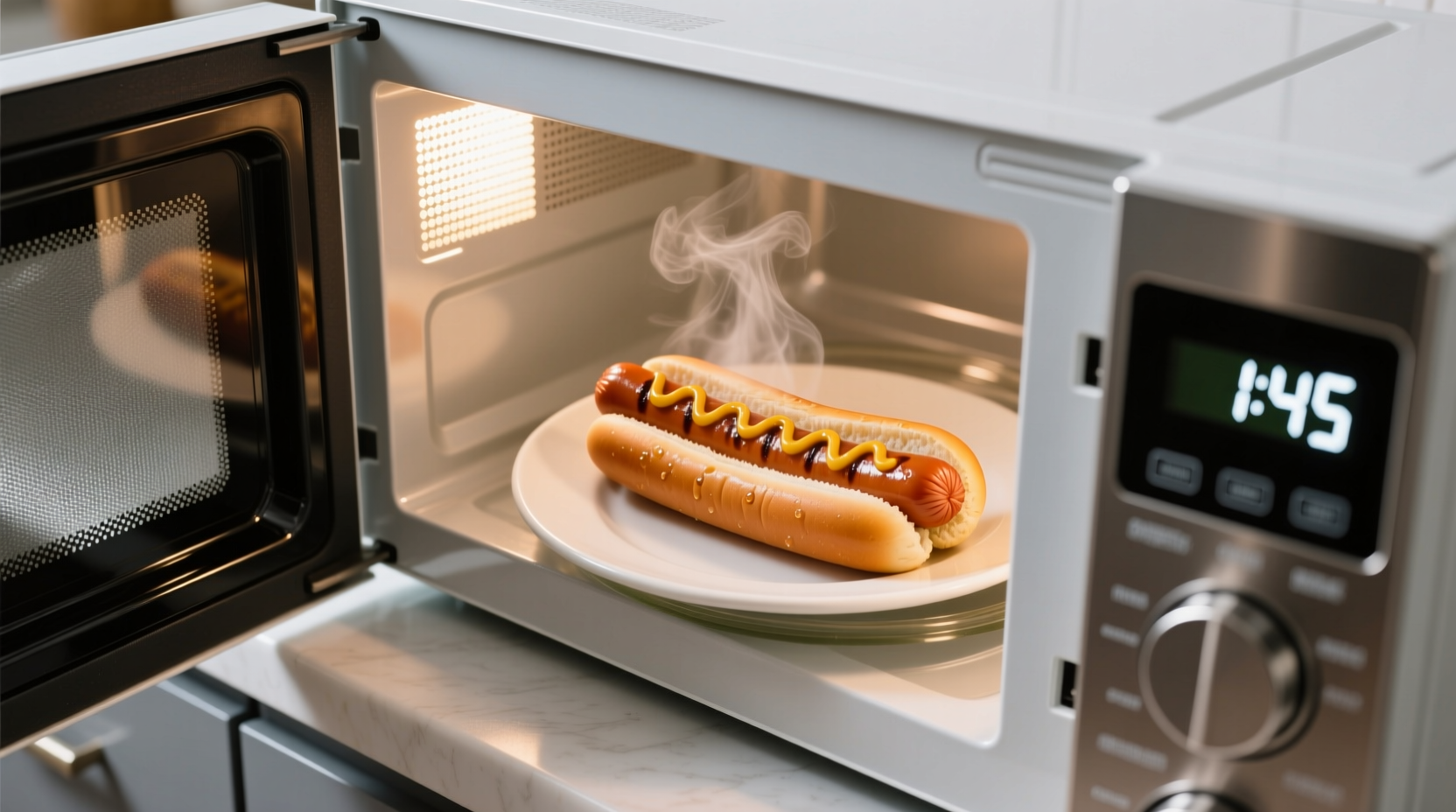Want a perfectly cooked hot dog in under two minutes without firing up the grill or stove? You're not alone—nearly 78% of microwave owners use this appliance for quick meal preparation according to USDA Food Safety and Inspection Service data. As someone who's taught thousands of home cooks professional techniques in both high-end restaurants and everyday kitchens, I've perfected the microwave hot dog method you can rely on.
Safety First: Why Proper Microwave Technique Matters
Microwaving hot dogs improperly can lead to dangerous temperature zones where bacteria thrive. The USDA recommends heating hot dogs until they reach 165°F (74°C) internally to eliminate potential listeria contamination. Unlike boiling or grilling, microwaves heat unevenly, creating cold spots that could harbor harmful bacteria if not handled correctly.
The Foolproof Microwave Hot Dog Method
Follow these professional-tested steps for consistent results every time:
- Prep your hot dog: Place on a microwave-safe plate and make 2-3 shallow diagonal cuts along the surface to prevent bursting
- Add moisture: Wrap in a damp paper towel or place in a microwave-safe bowl with 1 tablespoon of water
- Position correctly: Arrange hot dogs in a circle with space between them for even heating
- Microwave: Use recommended times based on your microwave wattage (see table below)
- Rest: Let stand for 30 seconds before handling to complete cooking through residual heat
- Verify temperature: Check with a food thermometer at thickest point
| Microwave Wattage | 1 Hot Dog | 2 Hot Dogs | 3-4 Hot Dogs |
|---|---|---|---|
| 1000W (Standard) | 45-75 seconds | 1–1½ minutes | 1½–2¼ minutes |
| 800W | 60-90 seconds | 1¼–1¾ minutes | 1¾–2½ minutes |
| 700W or lower | 75-105 seconds | 1½–2 minutes | 2–2¾ minutes |
Factors That Change Your Cooking Time
Several variables affect how long to cook a hot dog in the microwave. Understanding these helps you adjust on the fly:
- Starting temperature: Refrigerated hot dogs need 15-20% longer than room temperature
- Hot dog composition: All-beef varieties require slightly longer than pork-based options
- Plate material: Glass plates conduct heat differently than ceramic
- Altitude: Above 3,000 feet, add 10-15% to cooking time due to lower boiling point
Troubleshooting Common Microwave Hot Dog Problems
Even with perfect timing, issues can arise. Here's how to fix them:
Hot dogs bursting during cooking
This happens when steam builds up faster than it can escape. Always make those shallow diagonal cuts before microwaving, and never microwave hot dogs in their packaging. The Food Safety.gov recommends this simple prevention technique used by professional kitchens.
Cold spots in the hot dog
Rotate hot dogs halfway through cooking time. For multiple hot dogs, arrange them in a circle rather than a line to promote even exposure to microwave energy. Letting them rest after cooking allows heat to distribute evenly.
Dry or tough texture
Microwaves evaporate moisture quickly. Always include that small amount of water in the cooking vessel—it creates steam that keeps hot dogs juicy. Never microwave without moisture protection.
Pro Tips for Better Microwave Hot Dogs
Transform your quick meal with these professional techniques:
- Pre-toast buns: Place empty buns in microwave for 10 seconds before adding hot dogs
- Flavor infusion: Add a pinch of onion powder to the water for subtle flavor enhancement
- Texture boost: Finish with 15 seconds under the broiler for slight charring
- Condiment timing: Add cold toppings like mustard after cooking to maintain temperature integrity
When Not to Microwave Hot Dogs
While convenient, microwaving isn't ideal for all situations. The CDC advises that pregnant women, older adults, and immunocompromised individuals should avoid pre-cooked hot dogs unless reheated to 165°F. In these cases, boiling for 3-5 minutes provides more consistent temperature control than microwaving.
Frequently Asked Questions
Can you microwave frozen hot dogs directly?
Yes, but add 45-60 seconds to cooking time and check temperature carefully. Thawing in the refrigerator overnight yields more consistent results, but direct-from-frozen works in a pinch when properly heated to 165°F.
Why do hot dogs sometimes spark in the microwave?
This "arcing" occurs when minerals in the hot dog (particularly iron, magnesium, and selenium) interact with microwave energy. It's harmless but indicates uneven heating. Prevent it by ensuring hot dogs aren't touching and by using lower power settings for longer durations.
Is it safe to microwave hot dogs without water?
Technically yes, but not recommended. Without moisture, hot dogs become dry and tough much faster. The small amount of water creates steam that maintains texture and promotes even heating, reducing the risk of cold spots where bacteria could survive.
How do I know when a microwaved hot dog is done?
The only reliable method is checking internal temperature with a food thermometer—it must reach 165°F (74°C). Visual cues include steaming throughout, plump appearance without shriveling, and juices running clear. Never rely solely on cooking time as variables affect results.











 浙公网安备
33010002000092号
浙公网安备
33010002000092号 浙B2-20120091-4
浙B2-20120091-4